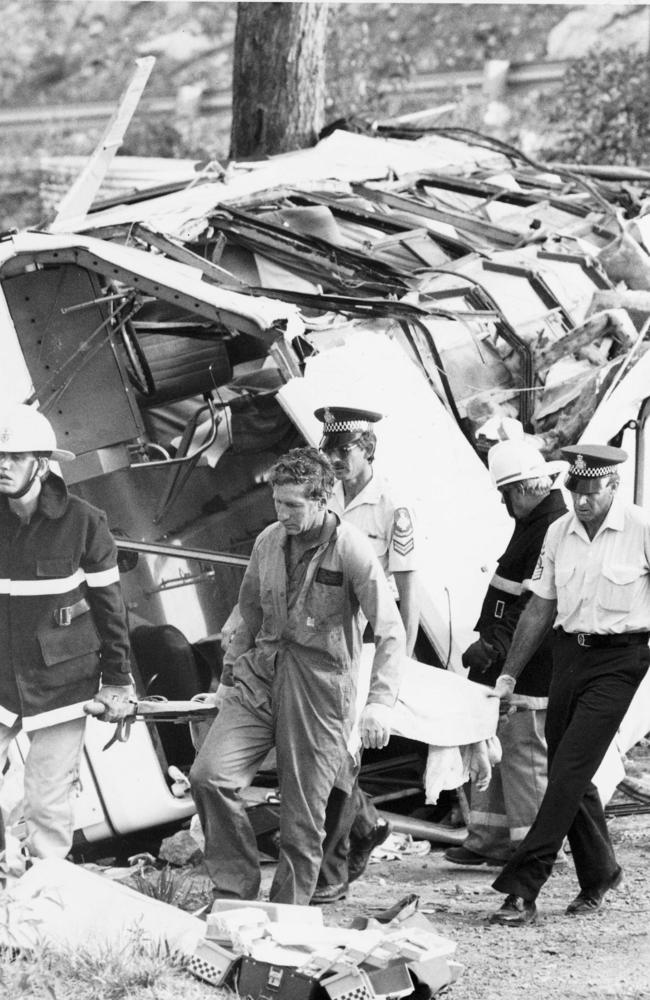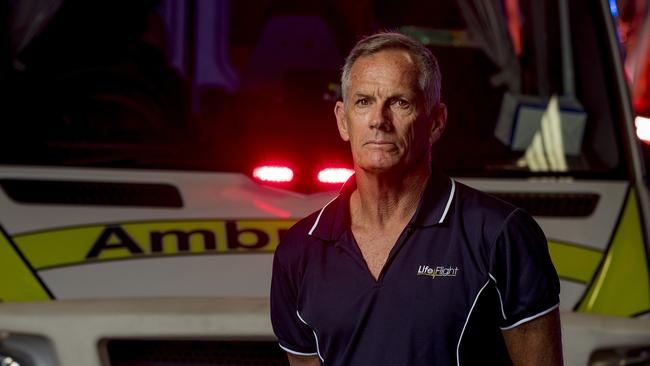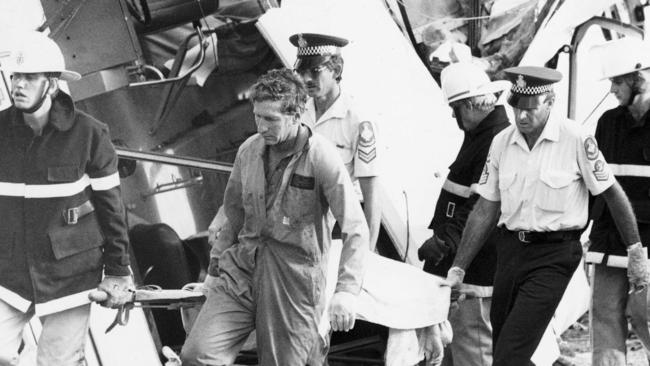“OH my god. We’re not going to make it.”
Those were the fateful words shouted by Kevin Eke from behind the wheel of his tour bus as it skidded down Tamborine Mountain’s steep Henri Robert Drive, with 53 terrified passengers aboard.
Smoke billowed from the back tires as the KJN Tours bus rocked back and forth at high speed before spectacularly crashing off the road just south of King Parrot Cr, rolling several times and showering the scene in debris.
THE PRIEST: HOW FATHER ANTHONY DAVID PRAYED WITH THE INJURED
Eileen Barron, from Yagoona in NSW, never had a chance. She was sitting next to husband Michael when the bus rolled. She was thrown from her seat out the window and was crushed moments later by the bus’ wreckage as it continued its death spiral, finally halted by a sturdy gum tree.
For a few moments, the busy road was consumed by the noise of the screeching tires, the cacophony of the bus tearing itself apart and the final impact against the tree.
Then silence fell.
It was 2.38pm on September 25 1990 and the Gold Coast had just had its worst-ever bus crash. By time night fell three hours later, 11 people were dead, 42 were injured and Australia was forever changed.
This the story of the disaster and how it affected those who witnessed it first-hand.
BEFORE THE CRASH
IT was supposed to be a relaxing trip to the Gold Coast Hinterland on the last day of a spring Queensland holiday.
The 53 passengers primarily comprised a group tour from a Newcastle senior citizens social club who were staying at Coolangatta’s Sunset Strip guesthouse.
KJN tours, which owned the Sunset Strip, had its bus arrive that morning to ferry its passengers to Thunderbird Park for a scenic tour.
FLASHBACK: GOLD COAST BUILDINGS NOW AND THEN

‘I’VE NEVER BEEN ABLE TO FORGET THE FACES OF THE PASSENGERS’
Kevin Eke was behind the wheel for the journey and, years later, was praised for his work through the morning and early afternoon.
The crash occurred on the return trip as the bus travelled down Henri Robert Drive.
Because of the road’s steep incline, Mr Eke was braking the entire way.
What caused the crash was never determined but coroner Leo O’Connell determined in a 1991 ruling that a faulty rear brake may have contributed to the accident.
THE CALL FOR HELP
It was nearly 3pm and Southport Ambulance Station was abuzz with activity as the morning shift prepared to changeover with the afternoon crew.
The weather was mild but it had been a sunny day and work for officers Cary Strong and Gavan Clark had been unremarkable. Both were inside the Nerang Street station when the call for help went out.

“I was out on road. I was doing the general pick patients up, take them to their appointments, that type of stuff. And then all of a sudden the radio started to heat up,” Mr Strong said.
Mr Clark, five years into his career as an ambulance officer, was in the first car to leave the station and arrive on-scene, some 40 minutes later.
He recalls arriving at the site of the crash and being shocked at the scene.
“The eerie thing about it was when we first arrived there was no noise, right?” he said. “If there had been a pram with say, young people, or school kids, there would be a lot of yelling and screaming.
FLASHBACK: INSIDE THE MERMAID BEACH CINEMA

“But because they were all elderly, no one was saying anything. No one was yelling, screaming or anything. So it was just this eerie silence.”
Mr Strong arrived not long after Mr Clark and was also struck by the lack of noise.
“I got out, you could hear an engine running, you could hear the odd moan of someone. But no yelling and screaming,” he said.
“It’s like it was in slow motion and it was silent. It was like someone had wound everything back. But then when you got to look at the seriousness of the patients, then you realised, okay, we’ve got a multi-system trauma.”
THE SCENE
A small army of police, ambulance officers, firefighters, State Emergency Services staff and volunteers from the community descended.
Bodies were strewn up and down the 25m embankment while survivors who had been able to escape the destroyed bus sat in a daze waiting to be treated. A temporary morgue was created with a tarpaulin behind the bus and bodies of the deceased placed there.

The numbers grew rapidly as ambulance officers tagged each patient they found – red for critical and black for the dead.
Mr Strong, who would go on to see some of Queensland’s worst road accidents in his long career, had been a full-time ambulance staff member for less than a year at the time.
Just 25 years old at the time, he remembers being stunned at the level of carnage.
“I think in hindsight about that tree … I always remember that bloody tree, stuck up against the bus.
“It stopped (the bus) from rolling. I’ve done a lot of learning in mass casualty from my early days and I believe that if that hadn’t had been there, I think it would have been a lot worse in regards to the injuries.

“(The scene) was basically like a washing machine. It was a challenge because we had to consider how do you take them (out of the bus) without causing further injury?
“At that stage, it was just basically a scoop, stretcher, get them on to the tarp area.”
A helicopter known as “the squirrel”, capable of carrying a single patient was brought in to carry the worst-injured of the crash victims to hospital.
Mr Strong said the ambulance service had never dealt with a situation like the crash at the time but emergency service workers were able to make snap decisions which saved lives.
‘The thing is, the ones you could talk to, listened to you and would help you,” he said.
FLASHBACK: REMEMBERING THE MERMAID BEACH MCDONALDS

“Unfortunately, others because of the nature of the injuries, just couldn’t and basically it was just splint, stop bleeding, get oxygen and get them loaded and just get them off that mountain and get them down.
“At one stage, I don’t even think we knew the true number. We were trying to find the manifest and work out how many people were on the bus, where it came from and that was confusing as all hell at one stage.”
THE AFTERMATH

The emergency services worked together to transport the patients off the mountain as fast as possible.
Mr Strong remembers the traffic being halted to allow the ambulances to get through
“The police had already started escorting us off the mountain and every intersection all the way through, from Nerang to the old hospital was basically stopped,” he said.
“As we were coming through, we got a clear run as the police bikes, leapfrogged us to the next intersection.”
Despite the trauma of the event, the shift wasn’t over and the ambulance officers who had attended the scene returned to their regular duties for the rest of the night.
MEMORIES

Both Mr Clark and Mr Strong were deeply affected by the events of September 25, 1990. Even 30 years later, memories of that day remain crystal clear.
Both men lament the lack of support available at the time for workers forced to visit traumatic scenes.
“Take a look at what we’ve got now, there’s that much support out there now, even within the organisation,” Mr Strong said.

“You’ve got your peer support and society today actually looks after you to a degree.”
Both continued with their careers, with Mr Strong still serving in the Queensland Ambulance Service today.
Mr Clark now has a first-aid training business and continues to work with Lifeflight.


Add your comment to this story
To join the conversation, please log in. Don't have an account? Register
Join the conversation, you are commenting as Logout
OPINION: How GC can ‘maximise every opportunity’ ahead of 2032
The Gold Coast must capitalise on early investments in public transport, community venues, new tourism experiences, enhanced tertiary education and leading-edge technology, writes Tom Tate
‘Golden opportunity’: Why this is our most important two years
The Gold Coast faces its most important two years this century - and must extend light rail south of Burleigh and clarify its identity before the 2032 Games, a leading demographer says.